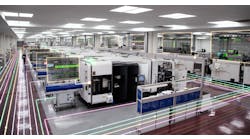Barfeeders (top) and probing – both tool and part – allow Hardinge turning centers at Grauch Enterprises to run unattended and over night.
A large portion of the work at Grauch Enterprises in Philpsburg, Pa., includes more than 650 different items for the U.S. Department of Defense. The parts, called “knobs,” are actually switch bolts for the “Ma Duce” M2 .50-caliber World War II-era automatic, tripod or vehiclemounted, belt-fed, recoil-operated, air-cooled machine guns.
From 2006 to 2007, the shop produced 188,943 parts that generated more than $2 million in sales, and the knob orders keep coming.
To meet such hefty job volumes, the shop relies on multitasking turning centers that pretty-much run themselves for unattended, lights-out operations.
Grauch Enterprises’s multitasking turning centers are a Quest Super-Precision 10/65 and a Quest 6/45, both from the Hardinge Group Inc. The machines’ automated features such as bar feeders and two touch probes – a tool probe and part probe – are key factors in Grauch’s lights-out operations.
The tool probe mounts on the wall of the machine near the spindle. When loading tooling, the machine’s turret moves out of the way. The touch probe comes down, then the turret is extended manually as the probe touches the C-axis and X-axis positions.
The information loads directly into the machine’s GE Fanuc control, so the machine knows where each tool is. The shop then indexes around and touches off all tools. That takes about five minutes. That ability lets Grauch Enterprises complete changeovers in 15 minutes to 30 minutes.
Grauch Enterprises produces, in lights-out machining operations, more than 9,000 “knobs” or switch bolts for machine guns.
The part probe, Fred Grauch, owner of Grauch Enterprises, said is used specifically on the .50-caliber switch bolts, and for running the parts at night.
“We have sub-programs where the part probe mounts on the turret and the turret will come every so many parts, say 20, and touch the turned areas where we are trying to hold. It will adjust the offsets in the machine to hold the desired tolerance, and as we get into production, we check every 10 or 5 parts, or each one if we want. You load the program that does self-inspection, and the Quest will inspect itself,” Grauch said.
The shop holds 0.0005 in., +/- 0.00025 in., on the .50-caliber switch bolts, a tolerance ensured by the part probe and the use of redundant tooling.
According to Grauch, the Quest adjusts a specified number of times, and after many cycles, the turning tool will have worn – on its edge, for example. The program then loads redundant tooling, and instead of using position “one,” it indexes to position “five.”
No matter what tool wears, the Quest will keep running. “We put enough material in the machine’s bar feeder to run for about 48 hours. If something happens – the feeder runs out of material, or the probe indicates we are not holding tolerance – the machine will stop and make a telephone call,” Grauch said.
“This is all done in the background, in the programming. What will happen is that whatever the problem, it will trip the emergency stop relay. There’s a device that you buy that hooks up to your phone and you program in your number. So when the machine gets an error code and shuts down, the relay is tripped and the machine calls a pre-programmed number of whoever is on call. This situation doesn’t happen often, but the system gives us confidence to load up the Quest and let it rip all night,” he added.
As time goes on, Grauch sees his shop replacing all of its gangstyle machines with Hardinges, one of which would replace two or three separate machines. The shop’s gang-style lathes worked great for small, quick runs, but parts come off the Quest machines complete.






